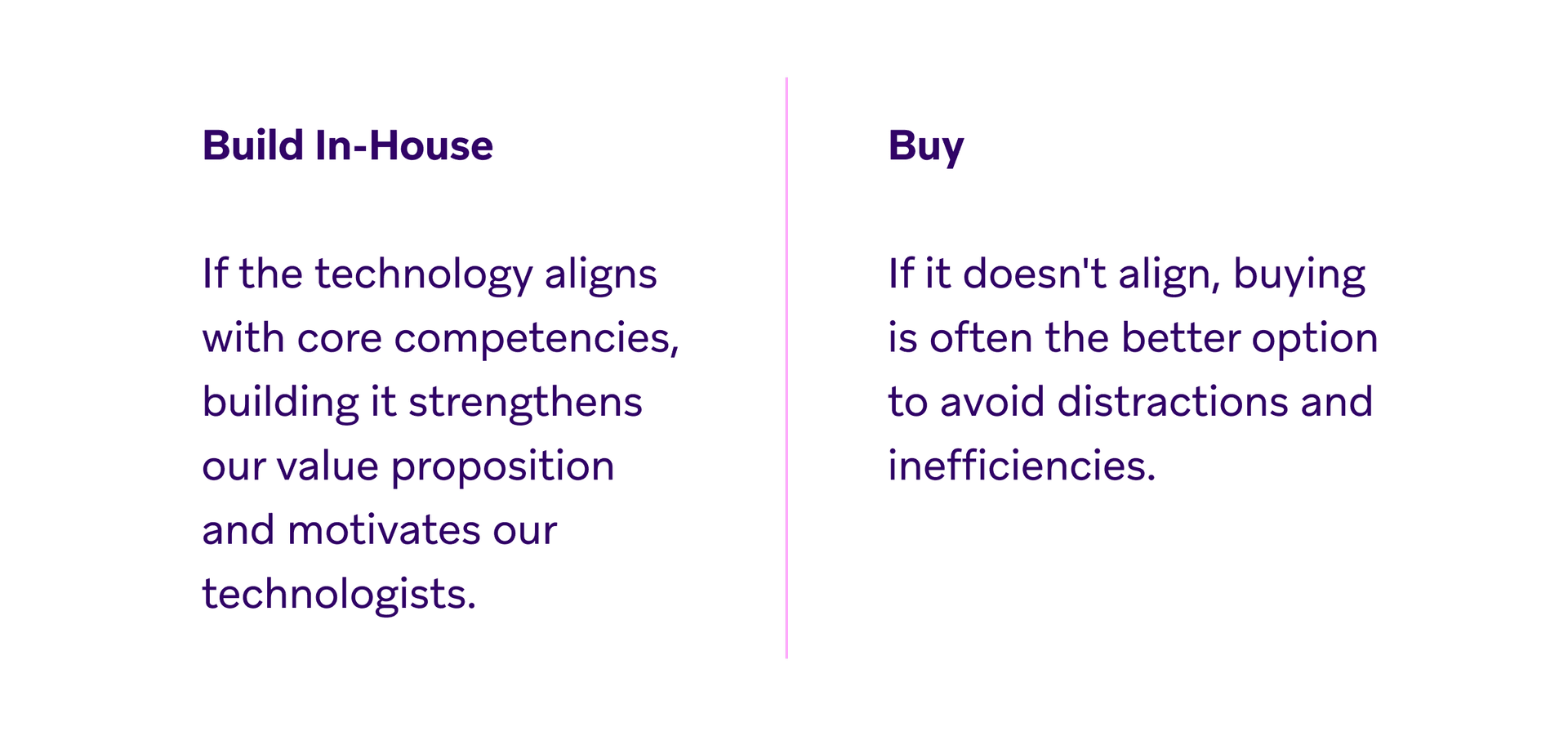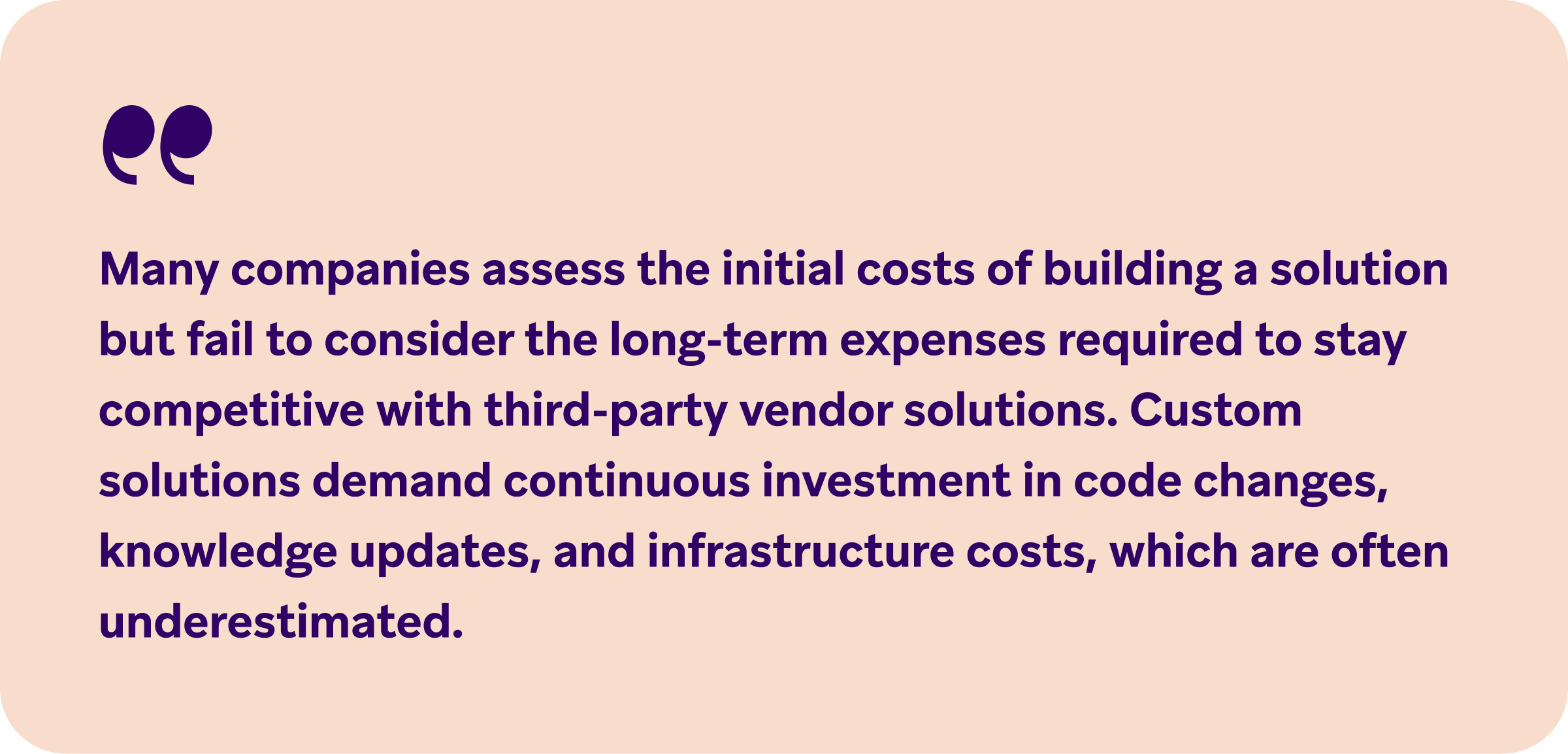A Technology Leader’s Perspective on Build vs. Buy
Published on July 25, 2024/Last edited on July 25, 2024/9 min read

Jamie Doheny
VP, Technology Services & Chief of Staff, Engineering, BrazeThis piece is part of an ongoing series on how technology and marketing leaders approach "Build vs. Buy" decisions. For another perspective, click here for insights from Miro's Tom Howard on how to drive the most impact when you decide to buy.
It's a common situation: Your organization identifies a new business need and wonders whether to buy an existing solution or build one in-house. If you're in a leadership role, especially in technology, you've likely faced this question—perhaps even now.
I have. My current role as VP, Technology Services at Braze has given me a unique perspective. I've been on all sides of the "Build vs. Buy" debate, both with the vendors that Braze uses and with our customers.
In this piece, I'd like to share insights from my experience to help other technology leaders make informed decisions about whether to build or buy technology solutions to meet business needs.
Why “Build vs. Buy” is such a persistent question
Before we dig into the questions technology leaders should consider in a "Build vs. Buy" scenario, let's explore why this question is so persistent in tech.
On the surface, the answer is easy: When faced with a problem, you can either buy a solution, build it yourself, or do nothing. However, this "Build vs. Buy" dilemma is unique to technology solutions—few companies debate building their own airplanes for international shipping, for example.
The difference lies in the perception that building software is easier than other complex tasks. Many companies have IT teams, and building in-house can seem like a cost-effective way to maintain control. This appeals to technology leaders who want to be masters of their own destiny, giving a sense of control and security in an often challenging landscape.
However, the reality is more complex. Companies often build technologies they could have bought without fully understanding the implications. Sometimes this works out, but often it doesn't. Moving forward with an in-house solution without a thorough assessment of the challenges can pose significant risks to long-term business success.
4 questions for technology leaders to consider when assessing whether to build or buy
To avoid that outcome, I've found that there are four key questions that technology leaders should ask themselves as they're considering the "Build vs. Buy" issue.
1. Is this technology related to your core competencies?
As a technology leader, the decision to build or buy technology hinges on its connection to our core competencies:

In practice, this means focusing on projects that directly contribute to our core business. For example, when I worked in Investment Technology at Bridgewater Associates, our teams worked on creating modeling engines, bi-temporal data stores, and highly redundant data processors. At Cigna healthcare, I worked on technology projects related to billing, claim processing, and underwriting tech. Why? Because those things served as the foundation of our overall efforts.
Building non-core technologies can create division within the team, leading to feelings of devaluation and potentially complicating hiring, promotions, and team transitions. This distraction can hinder retention and growth.
Many technology leaders opt to build non-core technologies to maintain control, fearing that buying might undermine their authority and primacy. However, this often results in inefficiencies and stretched resources, detracting from higher-priority projects that drive real impact.
The truth is, most of these technology organizations are understaffed, have long release windows and long project lifecycles, and stakeholders have to navigate complicated internal processes to successfully build non-core technologies in house.

Think of it this way: Why would you try to build a thing that is already readily available when you could be ruthlessly prioritizing projects that add immediately to your core value prop and set you apart from your competition?
I've learned that fostering openness and collaboration with other departments yields better results. Allowing other teams to buy or build non-core technologies benefits the company overall. Motivated technologists thrive when working on projects tied to the lifeblood of the company, rather than on arbitrary side projects.
2. Does this technology already exist and is it easy to buy?
At its core, the "Build vs. Buy" question is based on a couple assumptions:
- Your organization has the means and determination to build the technology.
- The technology is available from an outside vendor and can be purchased.
However, those are just assumptions: Sometimes the technology you need doesn't exist, making in-house development essential. Other times, it exists but is offered by only a few niche vendors, which may not be the best option due to lack of competition. But if there's a robust market with many competing tools, buying is often the smarter choice.
Consider this: If many top brands are using existing tools successfully, it indicates the advantages of buying. These vendors have a head start, dedicated resources, and industry insights that your in-house team may lack. They benefit from diverse client feedback and can quickly iterate and optimize their products.
The truth is, few in-house technologies can successfully compete with those advantages. And that's exactly why the biggest companies tend to buy instead of build when it comes to solutions that fall outside of their core competencies.
3. Do you need a best-in-class solution or just something basic?
While a third-party vendor often builds better technology than your organization can, not every solution needs to be the best. If you just need a temporary, good-enough solution, building in-house might make sense, even if superior products exist.
However, if the bare minimum won't meet your needs, that's a different story. Building great products is challenging. Your organization might create something functional in the time it takes to buy and implement a vendor's product, but it likely won't be best-in-class without significant dedication.
Consider Braze. We've been developing and improving our engagement software since 2011, and, as of July 25, 2024, we had over 25 product and engineering teams and 250+ R&D employees. In our 2024 fiscal year, our R&D expense represented 25% of our global revenue. This level of focus, investment, and subject area knowledge is necessary for our product to remain top notch, and it’s also really hard for brands to match in-house.
Ask yourself: How many people will you dedicate to building your own customer engagement solution? Often, Braze has more UI/UX/product design staff than the total engineers available in prospective customers' teams.
Sure, your organization could build a basic email “sender” cheaper than Braze, but achieving desired results usually requires more than just sending bulk emails. Companies choose Braze for features like real-time segmentation, automated retargeting, AI/ML optimization, and a full-featured orchestration engine. We rapidly iterate features across 10+ messaging channels, covering everything from composition and dynamic personalization to frequency capping, rate-limiting, and end-to-end delivery. And that doesn't even scratch the surface of what Braze makes possible.
Building a best-in-class solution is extremely difficult and resource-intensive. So, ask yourself:

4. Do you truly understand the total cost of ownership?
It's no secret that cost drives many companies to choose "Build" over "Buy." However, this perception often overlooks the long-term investment required to maintain and improve a custom solution.

We've seen this play out repeatedly. Brands with in-house solutions often face inefficiencies, especially under rapid user growth, leading to latency, technical debt, and siloed data. Maintenance is ongoing and can compound over time, consuming valuable resources and limiting innovation.
Third-party solutions like Braze offer distinct advantages. When brands choose Braze, for instance, they invest not only in our technology but also in our team. Our six-time award-winning global team of support managers and engineers has 24/7 coverage, which drives the quick resolution of issues, helps fine-tune integrations, solve break-fix issues, and quickly address platform bugs to accelerate time-to-value.
The reality is that any tool—whether you build it internally or purchase it from a third-party vendor—is going to have a learning curve for end users. Getting the most out of these tools is challenging for an organization if there aren't experts you can consult and processes in place to help new users get up to speed. Depending on their subscription entitlements, Braze customers may benefit, among others, from a dedicated customer success manager, onboarding manager, and solutions architect (as well as robust user guides and documentation, in-depth Braze Learning self-directed courses, and our global Braze Bonfire marketer community), providing quick setup, best practice advice, and custom solutions. This support, combined with our ready-to-use platform, means faster time-to-value compared to in-house solutions, which require internal development.
Additionally, technology constantly evolves. Changes to mobile platforms like iOS or Android necessitate updates. With Braze, new features (e.g. Dark Mode) are supported immediately upon release. In contrast, in-house solutions must wait for internal teams to implement these updates, potentially putting the company at a competitive disadvantage.
Another hidden issue associated with building non-core technologies in house? Opportunity cost. Engineering time is precious. When engineers focus on building non-core solutions, they divert attention away from your central product and make it harder to maintain competitive advantages in your field. Braze invests heavily in R&D, so that we can stay ahead of the curve in the customer engagement space; it's worth thinking about how much you're investing in your core area of focus and what potential opportunity costs might result from focusing more resources on a non-core initiative. Plus, these non-core projects often lack the specialized knowledge needed to meet specific requirements, resulting in suboptimal tools.

While building custom solutions can be beneficial in some cases, it's rarely cost-effective if done solely to save money. Without the same level of care and investment as third-party vendors, you risk shortchanging your company's future success.
Final thoughts
Every brand has unique technology needs based on their industry, audience, and the value they’re looking to deliver. Sometimes a custom solution is best, but often buying an existing one is more practical long-term. But whatever the situation may be, if you ask yourself those four questions above and think seriously about your answers, you can reduce the risk that you make a call that will negatively impact your business.
If you’re considering leveraging Braze to help meet your customer engagement needs and want a better understanding of what’s involved in that transition, check out our migration guide for integration best practices, expert advice on how to prepare, and data on average time to integration, time to data ingestion, and time to value.
Related Tags
Be Absolutely Engaging.™
Sign up for regular updates from Braze.


